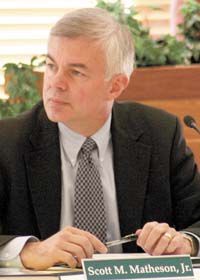| Scott Matheson |
Underground mine simulation equipment and site specific training were the chief goals and focus points defined by local educators as they testified before the Utah Mine Safety Commission on Tuesday.
The day long meetings at the College of Eastern Utah’s main campus began with testimony from school mining faculty and industry representatives. Their comments centered around educational needs within the Castle Valley area and the continuation of the melding between the Utah College of Applied Technology and the Western Energy Training Center.
Mining Department Chairman Dale Evans used his presentation to stress the underfunding of the mining program and to expose the need for more extensive training.
“We trained 1860 miners last year,” said Evans. “And we did it with four full time and two part time instructors. The Mining Safety and Health Administration’s states grant program is meant to subsidize a program not to support it and right now that grant coupled with tuition is the base for our program.”
According to Evans, the college also trained 480 miners outside of the area while commenting that the MSHA states grant program is decreasing every year.
“In 1980 the program was given $6 million for 36 states and last year the program was allocated $8.2 million for 49 states, the Navajo Nation and the Puerto Rico,” said Evans. “Each year our piece of the pie gets a little smaller.”
When asked what his recommendations would be for better training, Evans had several suggestions.
He reported that in West Virginia miners are required to take an 80 hour certification and pass a state competency exam before they can enter an underground coal mine, a training requirement double the minimum requirement in Utah, which also has no state exam.
Evans further recommended that Utah institute apprenticeship programs and require yearly recertification along with a more intensive annual refresher than the current eight hour program.
“It doesn’t hurt for all of us to learn new things,” said Evans, a third generation coal miner. “We also need to make sure miners, fire bosses and safety foremen are current with all new regulations.”
Evan’s last focal point was the necessity of on-sight training. He reported that the dangers are different at every facility and the only way to address those dangers is to conduct safety training at the work site.
Evans was asked by the commission to assemble hard numbers and re-approach the members with just what amount of funding these changes would require.
UCAT Director Miles Nelson who testified along with Evans provided the commission with he college’s current plans to move UCAT and the mining department to WETC facilities.
“WETC has worked with us to combine efforts and we are physically moving our programs to their facility. Additionally we have expanded to Emery County,” said Nelson.
One successful aspect of the UCAT program was the “open entry, open exit” availability of courses,which would remain intact as the program becomes part of the college.
“Students were able to come in and schedule their own competency based training, something that was beneficial to everyone,” said Nelson.
Following Evans and Nelson, Robert Topping was introduced by CEU administrator Brad King.
According to Topping, WETC is looking for $2 million to aid in construction simulation equipment to train power plant, longwall, roof bolter and continuous miner personnel in an environment that resembles facility working conditions.
“Studies conducted always show southeastern Utah as the epicenter for energy innovation. We can’t compete with other areas in energy production but what we can do is lead the way for energy related innovation,” said Topping.
Industry driven innovation is what is needed to aid in recruiting talent to an area primed to lose 70 percent of its workforce to retirement in the next 10 years, added the curriculum director
“Because of the coming mass retirement, low unemployment and our population it is easy to see that there is a real need for us to recruit talent to this area,” said Topping. “I feel education, government and industry need to come to the table and create a solution that will remedy the workforce needs in this area.”
“We develop our curriculum through industry driven need and input from safety organizations,” continued Topping. “We have to move to doing instead of knowing.”
“Right now, we have a workforce that has a 360 degree view of the industry and that type of knowledge is priceless. That is why a higher standard of training is so essential,” said Topping.
WETC’s master trainer program will assist some people in gaining extensive training knowledge.
According to Topping, the industry cannot replace its workforce with the current programs. The replacement will total 1.2 million retirees within the western region.
Evans and Topping stressed the need for a “safety community” within local mines.
Evans admitted that the current mining program offers no course on the psychology of safety. But he stressed the importance to develop a program that teaches energy employees to work safe at all times.
Topping indicated that the mine simulator was the number one priority for training at the WETC and the $2 million in funds would be earmarked for the project.
Evans also stated that costs for increasing the duration and effectiveness of the program would run in the millions.
Numbers from the college indicate that the state’s role in mine safety could cost the Utah Legislature upwards of $5 million annually.
“When we go to the regional MSHA state’s grants meetings ,we are praised and apologized to every year,” pointed out Evans. “They are amazed at what we do with the money we have. But that grant is meant to be a subsidy. I believe the state must buy into mine safety. We simply need better funding.”

